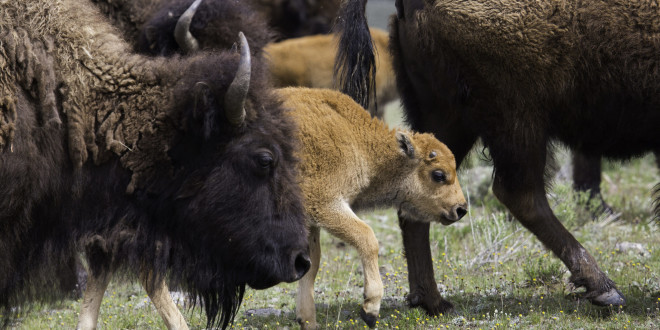Bison managers now say upward of 1,200 to 1,300 bison need to be culled to curb growth in Yellowstone National Park’s herd.
Previously, we reported Yellowstone officials had called for 900 bison to be culled. We also reported that count would be discussed among partner agencies of the Interagency Bison Management Plan. Now, per park biologist PJ White, speaking to the Bozeman Daily Chronicle, 900 may be too much on the low end, in terms of estimates:
“If you want to reduce the population significantly, you’re talking 1,200 or 1,300 bison,” White said.
State, federal and tribal officials met at Chico Hot Springs to finalize a winter bison management plan. The meeting was to put the final touches on a winter operations plan for bison management. The different government agencies are supposed to sign a plan by the end of the month that furthers the goals of the 2000 Interagency Bison Management Plan.
The 2000 plan grew out of Montana’s desire to keep the animals out of the state and livestock industry fears of the disease brucellosis, which can cause cattle to miscarry. More than half of Yellowstone bison are believed to at least have been exposed to the disease, but no case of transmission from bison to cattle has ever been documented.
The plan calls for a population of 3,000 in the Yellowstone region. Despite that goal, for the second year in a row they declined to put an exact number in their plan. Instead they said they want to “manage for a decreasing population.” The different agencies attempt to reduce the population through shipping bison to slaughter and hunting, but the population has grown instead of declined.
Last year, 384 bison were taken by hunters and 150 were caught in the Stephens Creek Capture Facility at the northern edge of the park. How many bison are ultimately removed depends on how many migrate out of the park. In a mild winter, they can stay inside the park’s boundaries much longer, keeping them safe from hunters and capture.
“The spring was warm early. Bison moved back into the park and weren’t available for either trapping or hunting,” said Dan Wenk, Yellowstone’s superintendent.
The other reason officials say the capture-for-slaughter numbers were low is because the park agreed to open the trap later in the year. They did so in order to give bison a chance to roam farther, but because of the low numbers they have decided to scrap that in hopes they will get closer to their goal of reducing the population.
“We’ve tried a lot of adaptive ways to get at this,” said Sam Sheppard, the regional supervisor for Montana Fish, Wildlife and Parks. “It didn’t work and we did not reach our decreasing goal.”
Tribal officials, such as Quincy Ellenwood of the Nez Perce Tribe, argue against a longer trapping season, saying it infringes on their treaty rights vis-à-vis hunting.
Jeremy Wolf, an official with the Confederated Tribes of the Umatilla Indian Reservation, also criticized the draft plan’s trapping rules, saying that officials were vague on how many bison would be allowed past Stephens Creek near the Park’s northern border. Although Wolf, speaking to the Chronicle, said the issue doesn’t dampen tribal support for the plan, he believes tribal entities are entitled to “more than a gut feeling” when it comes to bison hunting prospects.
Superintendent Wenk argued that the Park couldn’t provide an exact count to tribal hunters since he and other officials weren’t sure what bison would choose to do this winter, especially given the likelihood of a warmer spring driving bison back into Yellowstone.
 Yellowstone Insider Your Complete Guide to America's First National Park
Yellowstone Insider Your Complete Guide to America's First National Park





